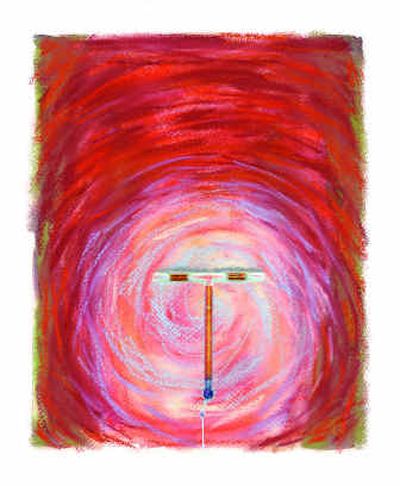Back in control

More and more women are taking a new look at an old form of birth control. A few decades ago, the mention of the IUD (intrauterine device) sent many women into a panic. A faulty IUD, the now-infamous Dalkon Shield, was pulled from the market in the mid-‘70s after being linked to infections, miscarriages and even some deaths.
But a new generation of women of child-bearing age, many who aren’t even aware of the IUD’s past, is rediscovering the device as a reliable, long-term form of reversible birth control.
“It’s just kind of slowly been picking up,” says Spokane obstetrician-gynecologist Dr. Lewis Meline. “We see more and more women doing that.”
There are currently two IUDs on the market in this country. Both are small, flexible, T-shaped devices that are inserted into the uterus by a health professional. A thin string hangs down into the vagina, allowing the wearer to ensure the IUD remains in place.
Neither device prevents ovulation.
One brand, the Mirena, releases a hormone into the lining of the uterus. This thickens the cervical mucous, making it difficult for an egg to be fertilized. Mirena can stay in place for up to five years.
“It puts the sperm to great disadvantage,” says Mirena spokeswoman Kim Schillace.
The other type of IUD on the market is the Copper T, made by ParaGard. No one knows for sure how this IUD prevents pregnancy. But it’s thought that the Copper T interferes with sperm mobility, fertilization and implantation. The Copper T can remain in the body for up to 10 years.
Despite the steady increase in use, IUDs continue to make up a fraction of the contraceptive market in the United States. At the height of their popularity in the 1970s, IUDs were used by about 10 percent of U.S. women on birth control. Today, less than 1 percent of women choose IUDs.
IUDs are popular in other countries, however, and they are the most widely used form of reversible contraception in the world.
But interest in IUDs continues to grow, experts say. (Makers of the devices have declined to release specific sales figures.)
Just six or seven years ago, Group Health midwife Margaret Egeland only saw one or two patients a year requesting IUDs. Now she inserts about 10 or 20 such devices in her patients every year.
“It’s a good method,” Egeland says. “It’s good for a lot of women. It’s not for everyone.”
Women who choose IUDs must be in monogamous relationships. The IUD does not cause pelvic inflammatory disease or other sexually transmitted diseases, but having an IUD can exacerbate such an infection. The risk of pelvic inflammatory disease is greatest in the weeks following the IUD’s insertion because bacteria may have been pushed into the uterus during the process.
IUDs used to only be recommended for women who had already given birth. But now it is known that women have never been pregnant can still get an IUD. IUDs have no impact on fertility; a woman can try to get pregnant the day her IUD is removed with the same rate of success as someone who had never had an IUD.
“I love it,” says Julie Hernandez, 24, a Washington State University student who has had an IUD since November.
Hernandez, who is married with no plans to have children in the near future, opted for the Copper T IUD after having a bad reaction to hormonal birth control. She says she would choose birth control pills if she could, but is happy with the IUD.
Hernandez admits that the insertion process was painful, and that her periods were heavy for a couple of months. But she enjoys not having to worry about contraception.
“You can be spontaneous whenever you dang well please,” says Hernandez, a volunteer with Planned Parenthood in Pullman who hopes to go to medical school. “That’s kind of the fun thing about it.”
Lusy Loshkarev, who came to this country from Russia 10 years ago, has had her most-recent copper IUD for a year. Before that, the 29-year-old mother of three wore an IUD for eight years.
“I like it,” says Loshkarev, who adds that her periods are longer than usual with the IUD. “But you’re still safe from pregnancy and that’s OK.”
The Mirena IUD, which sends hormones into the uterus, has the opposite effect on menstruation. It often produces shorter, less-heavy periods in the women who use it.
Spokane resident Katie Womack, 22, says she used to suffer from severe cramps and heavy bleeding each month.
On Mirena, though, “My period is a lot lighter,” Womack says.
And about 20 percent of women using Mirena have no periods at all after the first year, Schillace says.
The IUD is a cost-effective option as well, one that is paid for by all insurance companies covering contraception. IUDs typically cost a few hundred dollars, which is about how much women would spend on a year or two of birth-control pills.
Egeland expects to see the number of women choosing IUDs continue to grow.
“I’m sure it will become increasingly popular,” she says. “It just has too many good things about it. It’s long-acting. There’s nothing to bother with at the time of intercourse or to remember to do everyday. It’s better than 99-percent effective … There really are so few side effects.”